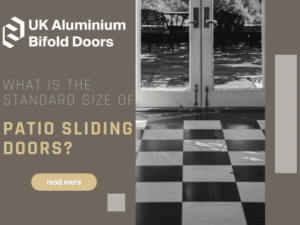Most bifold doors have custom-made manufacturing sizes according to requirements. As people from different walks of life have diverse needs, and every house is different, the specifications for bifold doors also vary. For this reason, incorrect measurements at the start can ruin a project and create unnecessary headaches for manufacturers and installers.
It can also massively impact the cost of bifold doors, which is what makes these measurements so important.
Due to the flexible nature of a bi-folding door, the utmost care must be taken from the smallest measurements to ensure no mistakes are made. We’ve put together this guide to assist with how to measure bifold doors most accurately to limit any chances of error.
How to Measure the Aperture for BiFold Doors
The aperture is the opening in which your bifold doors will fit. It should include a level, flat floor, two vertical sides at 90-degree angles to the bottom, and a top running parallel to the floor. Use a large spirit level to check your vertical and horizontal walls to ensure they’re accurate and square.
If your top and floor run parallel and level to each other and your sides are at right angles, your aperture will be perfectly square.
Taking measurements for the aperture of a bifold door hardly differs from how you take measurements for patio doors, but there are a few vital distinctions.
With a bifold door, you’re required to pay special attention to the tracking hardware above and below the door and the height measurements of the threshold. Besides that, measuring for bifold doors is no different from measuring for sliding doors.
You can call in an expert to carry out the measuring and other necessities needed for fitting your bifold doors, or you can do it yourself. Either way, we hope our guide will provide you with greater insight into the process and the need for accuracy.
Measure the outside width
Like the door frame for any external doors, the outer frame of bifold doors must be installed to be perfectly square and level. This will ensure that your doors will fit suitably and function as they should.
The first measurements you’ll need are the outside ones, beginning with the aperture’s width. For this guide, we’ll assume that the opening is prepared and ready for the installation of the door.
You should take three measurements horizontally across the opening. Your measurements should be from wall to wall, ideally including a side-to-side top section, middle section and bottom section width. Write down each measurement you make, but it’ll be the smallest width you’ll use as the foundation for the door installation.
Measure the outside height
As you did with the width, measure the outside height by making three height measurements in the same way and write them down. Make special notes of the smallest measurements again.
It’s also necessary to note the height of your current threshold and to contemplate what future entry threshold you’ll require. Particular bifold doors come with flush or lower entry thresholds to provide easier access for baby carriages and wheelchairs.
Measure the outside diagonals
Take diagonal measurements from the left bottom corner to the right top corner and vice versa. These measurements should ideally be the same, or at least very close to each other. Please note these, too, as the bifold door manufacturer may require them.
Don’t worry if your aperture doesn’t seem to be exactly square after measuring the diagonals, as this can be easily rectified during the door fitting.
The Importance of accurate measurements
It’s essential to measure as accurately as you can for the following reasons:-
- It’ll be much easier to achieve the floor level transition from outside to the interior if precise measurements are taken.
- You might need to alter the step-over height for doors that open outwards slightly.
- You’ll need to make sure that doors that inward-opening won’t scrape against and damage the inside flooring.
Compile the final measurements for ordering
Once you’ve taken all the necessary measurements, please note the shortest width and height figures and then deduct 10 millimetres from them. You’re doing this as your new bifold doors will have slightly smaller manufacturing sizes than those you’ve measured to ensure clearance and easy fitment.
If a fitment team is coming out, they will also check the condition of your walls to ensure they are strong enough to accommodate the door’s outer frame.
Potential Manufacturer Questions
When you place your order for your bifold doors, the manufacturers will likely need specific information before making your folding doors. Be prepared with answers to the following questions:-
- What colour will your doors be?
- How many door panels would you like to include?
- Will your doors fold inwards or outwards?
- Should the doors fold to the left, right, or both ways from the centre?
- Will you need a traffic door?
- Should we allow space for patio slabs, carpeting or floor tiles?
The more information you’ve considered and have answers for, the easier the bifold door fitting process will be. Visit our website to find out how to fit bifold doors and further tips on aluminium doors.
FAQs
How can I find out the size of a bifold door to buy?
Measure the height on the left and right sides and through the centre. Take the smallest measurement and subtract the fitting tolerance of 10mm to ascertain the door size you’ll need to buy. Make sure you know whether the doors should open to the inside or outside, and check if there’s enough space.
If your doors are measured right and still struggling to fit, you may need to adjust the hinges of your bifold door instead.
How do I measure to fit interior bi-folds?
Remove existing doors before measuring. Measure the opening’s top, middle and bottom horizontally and the left, right and centre vertically, and write down the smallest figures for both. Check the clearance distance your door will require. Check with an expert about how much space you’ll need for hardware and tracks.
Is there a trend that’s replacing bifold doors?
Not really, although a sliding door is the best alternative to bifold doors when upgrading old patio doors. The problem with sliding doors is they don’t give you full doorways like bifold doors do when open.






